Plant Science Research Weekly: July 12, 2024
Review: Root development and symbiosis: an epigenetic perspective
 Roots do not grow in isolation but occupy a space inhabited by a variety of organisms. With certain fungi and bacteria, they form partnerships or symbiotic relationships that increase the plant’s nutrient uptake and assimilation. While the knowledge on the genetic programs required to establish these symbiotic relationships is a topic of many studies, the epigenetic regulation of the involved genes is less known. In this recent review by Zanetti et al. (2024), the authors provide a comprehensive overview of the current knowledge on epigenetic regulation of root development. Specifically, the review covers three aspects of root development, namely lateral root development, nodule formation, and symbioses with mycorrhizae, and it discusses how both DNA methylation and histone modifications act to control the relevant genes. In particular, the article highlights differences in the epigenetic regulation among different root zones, tissues, and even cell-types. The emphasis on these spatial characteristics provide interesting, novel perspective on the subject. Finally, the authors argue for more research towards unravelling the epigenetic regulation of root system architecture and symbiosis, especially with respect to the role of chromatin remodelling and histone modifications, to better understand the underlying drivers for the enormous phenotypic plasticity demonstrated by a plant root. (Summary by Thomas Depaepe @thdpaepe). Plant Physiology 10.1093/plphys/kiae333
Roots do not grow in isolation but occupy a space inhabited by a variety of organisms. With certain fungi and bacteria, they form partnerships or symbiotic relationships that increase the plant’s nutrient uptake and assimilation. While the knowledge on the genetic programs required to establish these symbiotic relationships is a topic of many studies, the epigenetic regulation of the involved genes is less known. In this recent review by Zanetti et al. (2024), the authors provide a comprehensive overview of the current knowledge on epigenetic regulation of root development. Specifically, the review covers three aspects of root development, namely lateral root development, nodule formation, and symbioses with mycorrhizae, and it discusses how both DNA methylation and histone modifications act to control the relevant genes. In particular, the article highlights differences in the epigenetic regulation among different root zones, tissues, and even cell-types. The emphasis on these spatial characteristics provide interesting, novel perspective on the subject. Finally, the authors argue for more research towards unravelling the epigenetic regulation of root system architecture and symbiosis, especially with respect to the role of chromatin remodelling and histone modifications, to better understand the underlying drivers for the enormous phenotypic plasticity demonstrated by a plant root. (Summary by Thomas Depaepe @thdpaepe). Plant Physiology 10.1093/plphys/kiae333
Review: Back-of-the envelope Fermi calculations in plant science
 I think one of the most important lessons a scientist learns is to cross-check their findings with a different approach in order to determine if the findings are reasonable. This interesting article by Oliveira-Filho and Campos-Silva et al. lays out several examples of using back-of-the envelope or Fermi calculations to “gauge reality”. The authors provide a step-by-step guide including a logic chain and then demonstrate how this is done in practice. As an example, consider the feasibility of aviation “going green” by using only bio-jet fuels to power planes. It sounds like a great plan, but is it achievable? I’ll leave you to find the answer in the article. I think this resource can be quite useful for educators; an instructor can pose the provided questions to students, ask them for their a priori responses, and then ask them to run their calculations using the guidance provided. Sample calculations are provided to determine the amount of nitrogen fertilizer needed to replace the nitrogen harvested with corn grain, how much nitrogen fixed by the Haber-Bosch process can be replaced by legume cover crops, and others. This article is part of a Plant Physiology Focus Issue on the topic of Numeracy, Realism, and Relevance in Plant Science, coming out in May, 2025. (Summary by Mary Williams @PlantTeaching) Plant Physiol. 10.1093/plphys/kiae347
I think one of the most important lessons a scientist learns is to cross-check their findings with a different approach in order to determine if the findings are reasonable. This interesting article by Oliveira-Filho and Campos-Silva et al. lays out several examples of using back-of-the envelope or Fermi calculations to “gauge reality”. The authors provide a step-by-step guide including a logic chain and then demonstrate how this is done in practice. As an example, consider the feasibility of aviation “going green” by using only bio-jet fuels to power planes. It sounds like a great plan, but is it achievable? I’ll leave you to find the answer in the article. I think this resource can be quite useful for educators; an instructor can pose the provided questions to students, ask them for their a priori responses, and then ask them to run their calculations using the guidance provided. Sample calculations are provided to determine the amount of nitrogen fertilizer needed to replace the nitrogen harvested with corn grain, how much nitrogen fixed by the Haber-Bosch process can be replaced by legume cover crops, and others. This article is part of a Plant Physiology Focus Issue on the topic of Numeracy, Realism, and Relevance in Plant Science, coming out in May, 2025. (Summary by Mary Williams @PlantTeaching) Plant Physiol. 10.1093/plphys/kiae347
Gene knock-down using gene editing
 An efficient method of gene downregulation, where gene expression is reduced but not completely knocked out, is useful for crop improvement. Here, Shen et al. have developed a system to achieve this, by using CRISPR/Cas9 to insert an element containing a Kozak sequence and an ATG start codon just before the primary start codon of the gene they wish to silence. This new ATG site acts as a competitor to the primary start codon, and leads to a reduction in translation of the normal transcript. The was tested in dual luciferase assays in rice protoplasts and led to ~75% reduction in expression of target genes. They then applied it to a commercial rice variety to downregulate the amylose synthesis gene Waxy. Plants with the gene knock-down element inserted upstream of Waxy had lower Waxy expression and had a milky coloured endosperm, which is indicative of reduced amylose content. Thus, this approach has been shown to successfully decrease gene expression in crop plants. (Summary by Rose McNelly @Rose_McN) New Phytol. 10.1111/nph.19856
An efficient method of gene downregulation, where gene expression is reduced but not completely knocked out, is useful for crop improvement. Here, Shen et al. have developed a system to achieve this, by using CRISPR/Cas9 to insert an element containing a Kozak sequence and an ATG start codon just before the primary start codon of the gene they wish to silence. This new ATG site acts as a competitor to the primary start codon, and leads to a reduction in translation of the normal transcript. The was tested in dual luciferase assays in rice protoplasts and led to ~75% reduction in expression of target genes. They then applied it to a commercial rice variety to downregulate the amylose synthesis gene Waxy. Plants with the gene knock-down element inserted upstream of Waxy had lower Waxy expression and had a milky coloured endosperm, which is indicative of reduced amylose content. Thus, this approach has been shown to successfully decrease gene expression in crop plants. (Summary by Rose McNelly @Rose_McN) New Phytol. 10.1111/nph.19856
Posttranslational regulation of photosynthetic activity via the TOR kinase in plants
 In the dazzling dance of plant cellular life, chloroplasts must groove in harmony with growth to sidestep the perils of photooxidative damage. This harmony between photosynthesis and photooxidative damage is orchestrated by the guanosine tetraphosphate (ppGpp) signalling pathway which traces its roots back to prokaryotic origins. RelA SpoT homolog 3 (RSH3), a nuclear-encoded enzyme, is crucial for ppGpp biosynthesis, which negatively regulates photosynthesis. The LST8 subunit of the TOR complex, a growth-promoting kinase, interacts with and phosphorylates the N-terminal region (NTR) of RSH3, highlighting a post-translational regulatory mechanism. The localization of RSH3 is intricately linked to its NTR’s phosphorylation status; the phosphomimic version of RSH3 oscillates between chloroplast and nucleocytosolic locations, while the phospho-null version shows chloroplastic localization. Inhibiting TOR disrupts the phosphorylation, leading to increased presence of RSH3 in the chloroplasts, elevated ppGPP levels, and inhibition of photosynthesis. This TOR-centric regulation of ppGPP levels and photosynthesis offers a rapid response mechanism ensuring coordinated growth and photosynthesis, that might be handy especially under stress conditions. Ultimately, this study reveals a sophisticated mechanism where TOR keeps chloroplasts in check, preventing oxidative mayhem and ensuring the plant’s survival. (Summary by Nibedita Priyadarshini) Science Advances. 10.1126/sciadv.adj3268
In the dazzling dance of plant cellular life, chloroplasts must groove in harmony with growth to sidestep the perils of photooxidative damage. This harmony between photosynthesis and photooxidative damage is orchestrated by the guanosine tetraphosphate (ppGpp) signalling pathway which traces its roots back to prokaryotic origins. RelA SpoT homolog 3 (RSH3), a nuclear-encoded enzyme, is crucial for ppGpp biosynthesis, which negatively regulates photosynthesis. The LST8 subunit of the TOR complex, a growth-promoting kinase, interacts with and phosphorylates the N-terminal region (NTR) of RSH3, highlighting a post-translational regulatory mechanism. The localization of RSH3 is intricately linked to its NTR’s phosphorylation status; the phosphomimic version of RSH3 oscillates between chloroplast and nucleocytosolic locations, while the phospho-null version shows chloroplastic localization. Inhibiting TOR disrupts the phosphorylation, leading to increased presence of RSH3 in the chloroplasts, elevated ppGPP levels, and inhibition of photosynthesis. This TOR-centric regulation of ppGPP levels and photosynthesis offers a rapid response mechanism ensuring coordinated growth and photosynthesis, that might be handy especially under stress conditions. Ultimately, this study reveals a sophisticated mechanism where TOR keeps chloroplasts in check, preventing oxidative mayhem and ensuring the plant’s survival. (Summary by Nibedita Priyadarshini) Science Advances. 10.1126/sciadv.adj3268
Convergent evolution of desiccation tolerance in grasses
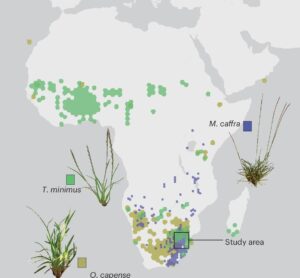 Many bryophytes and other non-seed plants are tolerant to vegetative desiccation, which is thought to have been necessary for colonization of land. By contrast, most seed plants lack this capacity, although they retain desiccation tolerance in their pollen and seeds. However, some seed plants, known as resurrection plants, have re-evolved vegetative desiccation tolerance probably through co-option of the retained ancestral pathways. In general, vegetative desiccation tolerance involves the accumulation of osmoprotectants and robust systems for protection from photooxidative damage. In a new work, Marks et al. took a comparative genomics approach to investigate the mechanisms of desiccation tolerance in a set of grasses from sub-Saharan Africa. They found that genes previously shown to contribute to desiccation tolerance, including early light-induced proteins (ELIPs), show high levels of gene expansion as well as elevated expression during desiccation. Interestingly, some species share a single origin of ELIP expansion, indicating parallel evolution, whereas in others gene expansion has occurred independently, suggesting convergent evolution. The authors extend their findings to identify shared signatures of desiccation tolerance, providing further evidence of convergence across species. (Summary by Mary Williams @PlantTeaching) Nature Plants 10.1038/s41477-024-01729-5
Many bryophytes and other non-seed plants are tolerant to vegetative desiccation, which is thought to have been necessary for colonization of land. By contrast, most seed plants lack this capacity, although they retain desiccation tolerance in their pollen and seeds. However, some seed plants, known as resurrection plants, have re-evolved vegetative desiccation tolerance probably through co-option of the retained ancestral pathways. In general, vegetative desiccation tolerance involves the accumulation of osmoprotectants and robust systems for protection from photooxidative damage. In a new work, Marks et al. took a comparative genomics approach to investigate the mechanisms of desiccation tolerance in a set of grasses from sub-Saharan Africa. They found that genes previously shown to contribute to desiccation tolerance, including early light-induced proteins (ELIPs), show high levels of gene expansion as well as elevated expression during desiccation. Interestingly, some species share a single origin of ELIP expansion, indicating parallel evolution, whereas in others gene expansion has occurred independently, suggesting convergent evolution. The authors extend their findings to identify shared signatures of desiccation tolerance, providing further evidence of convergence across species. (Summary by Mary Williams @PlantTeaching) Nature Plants 10.1038/s41477-024-01729-5
Using a historic wheat collection to revolutionize breeding
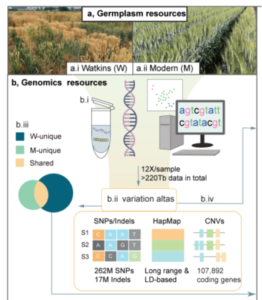 Wheat (Triticum aestivum) is an important crop, making up ~20% of food consumed worldwide. As the population grows, wheat yields must increase to meet demand. To achieve this, genetically diverse wheat landraces (aka traditional varieties, which are locally adapted cultivars) can be utilized. Here, Cheng et al. whole-genome sequenced 827 wheat landraces from the Watkins collection, which was collected in the 1920’s and 1930’s from 32 countries. These were divided into seven groups, five of which do not overlap with modern wheat, hence containing novel diversity. Further analysis identified 162 million single nucleotide polymorphisms (SNPs) in the Watkins collection which are absent from modern wheat. Nearly 14000 of these affect gene function and are in genes that have no variation in elite wheat cultivars. Ontology term analysis revealed that these genes are associated with yield, disease resistance and stress tolerance, so these SNPs could be important for breeding. The authors introduced some of this variation into the modern wheat Paragon and used field trials to demonstrate how the Watkins collection could be used in pre-breeding. Overall, this study provides a plethora of data that could revolutionize breeding; to do so the authors have made the data available at https://wwwg2b.com/. (Summary by Rose McNelly @Rose_McN) Nature 10.1038/s41586-024-07682-9
Wheat (Triticum aestivum) is an important crop, making up ~20% of food consumed worldwide. As the population grows, wheat yields must increase to meet demand. To achieve this, genetically diverse wheat landraces (aka traditional varieties, which are locally adapted cultivars) can be utilized. Here, Cheng et al. whole-genome sequenced 827 wheat landraces from the Watkins collection, which was collected in the 1920’s and 1930’s from 32 countries. These were divided into seven groups, five of which do not overlap with modern wheat, hence containing novel diversity. Further analysis identified 162 million single nucleotide polymorphisms (SNPs) in the Watkins collection which are absent from modern wheat. Nearly 14000 of these affect gene function and are in genes that have no variation in elite wheat cultivars. Ontology term analysis revealed that these genes are associated with yield, disease resistance and stress tolerance, so these SNPs could be important for breeding. The authors introduced some of this variation into the modern wheat Paragon and used field trials to demonstrate how the Watkins collection could be used in pre-breeding. Overall, this study provides a plethora of data that could revolutionize breeding; to do so the authors have made the data available at https://wwwg2b.com/. (Summary by Rose McNelly @Rose_McN) Nature 10.1038/s41586-024-07682-9
Shoot impairments upon root waterlogging
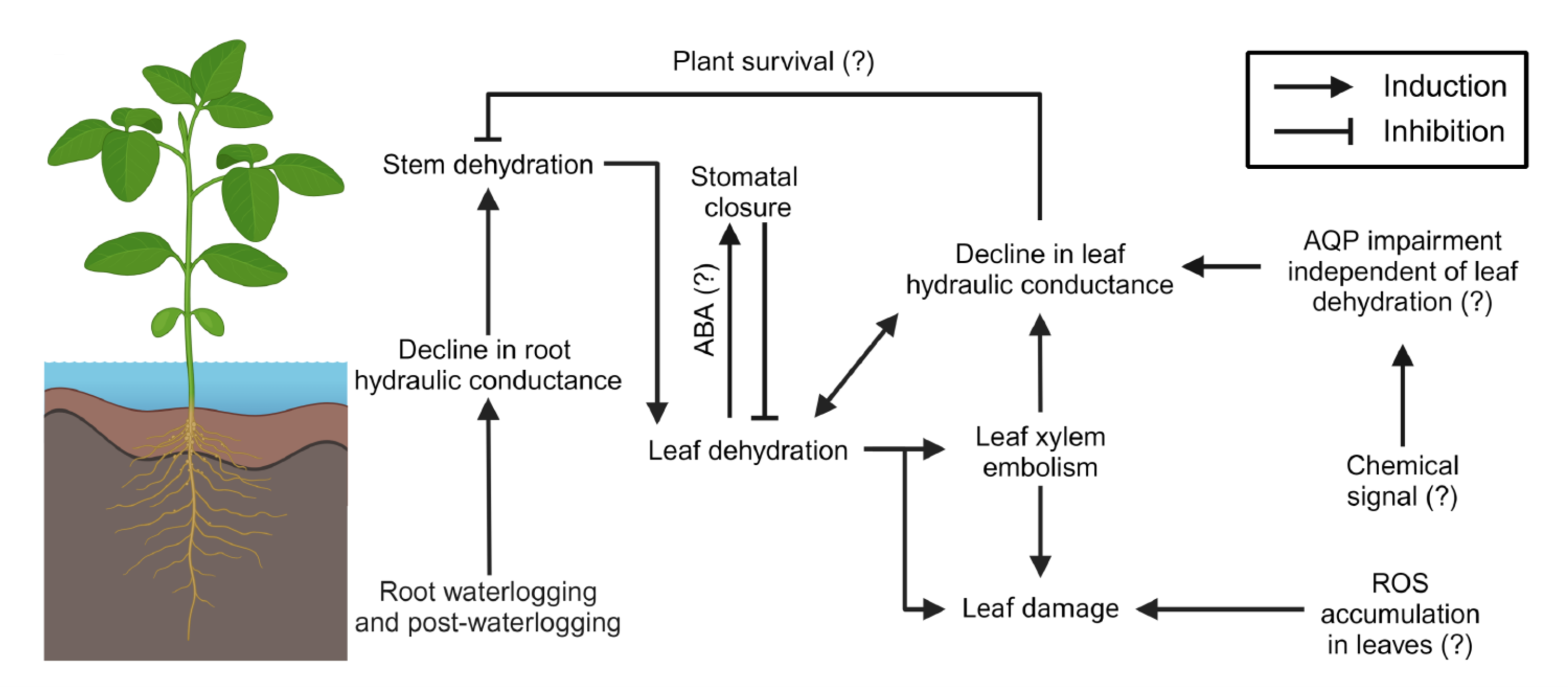 In this article by Haverroth et al., the authors explore plant-water dynamics in the shoot during and after waterlogging, using as a model Phaseolus vulgaris, which is particularly sensitive to waterlogging. One of the interesting findings is that early after waterlogging and prior to leaf dehydration, stomatal pores close and leaf hydraulic conductivity declines; the stomatal closure may be a response to increased ABA levels. Additionally, the early decreases in leaf hydraulic conductance are likely due to a downregulation of aquaporin expression, such as previously observed in roots. After soil drainage, leaf hydraulic conductance continues to decrease, leading to embolism formation, dehydration, and cell damage. The authors suggest that the decrease in hydraulic conductance in leaves acts as a “circuit breaker” to protect the stem from embolism formation, which is much more likely than leaf damage to cause plant death. (Summary by Mary Williams @PlantTeaching) Plant Physiol. 10.1093/plphys/kiae336
In this article by Haverroth et al., the authors explore plant-water dynamics in the shoot during and after waterlogging, using as a model Phaseolus vulgaris, which is particularly sensitive to waterlogging. One of the interesting findings is that early after waterlogging and prior to leaf dehydration, stomatal pores close and leaf hydraulic conductivity declines; the stomatal closure may be a response to increased ABA levels. Additionally, the early decreases in leaf hydraulic conductance are likely due to a downregulation of aquaporin expression, such as previously observed in roots. After soil drainage, leaf hydraulic conductance continues to decrease, leading to embolism formation, dehydration, and cell damage. The authors suggest that the decrease in hydraulic conductance in leaves acts as a “circuit breaker” to protect the stem from embolism formation, which is much more likely than leaf damage to cause plant death. (Summary by Mary Williams @PlantTeaching) Plant Physiol. 10.1093/plphys/kiae336
Harnessing the potential of soil microbial allies to combat Striga infection in sorghum roots
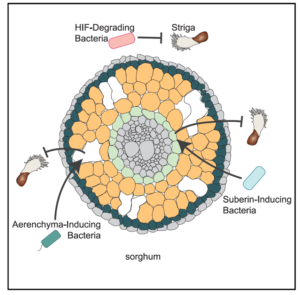 Microbial neighbors of plants in the soil comprise of a vast array of bacteria and fungi, collectively known as the microbiome. This soil microbial community forms close associations with plants and regulates plant growth and development by inducing changes in the plant and soil metabolites. In this study, Kawa et al. explored the role of the soil microbiome in suppressing sorghum root infection by the parasitic weed Striga hermonthica. Sorghum suffers 20% yield loss annually amounting to 6 million tons of grain loss due to infection by Striga, leading to food insecurity, especially in sub-Saharan Africa where it is one of the most important and staple cereal crops. This study showed that Striga attachment in roots is lower in natural soil compared to sterilized soil, indicating that the soil microbial communities play a significant role in suppressing parasitic infection in the host plants. The authors showed that the microbiome suppresses the formation of haustoria, the Striga structure necessary to penetrate the host root, by degrading haustorium-inducing factors. Moreover, significant changes were detected in the root anatomy including increased suberin and aerenchyma formation, which deters parasitic penetration of the roots. Thus, by identifying the underlying mechanisms of microbiome-mediated suppression of root infection, this study paves way for developing better management of Striga infection in roots. (Summary by Abira Sahu @AbiraSahu) Cell Reports 10.1016/j.celrep.2024.113971
Microbial neighbors of plants in the soil comprise of a vast array of bacteria and fungi, collectively known as the microbiome. This soil microbial community forms close associations with plants and regulates plant growth and development by inducing changes in the plant and soil metabolites. In this study, Kawa et al. explored the role of the soil microbiome in suppressing sorghum root infection by the parasitic weed Striga hermonthica. Sorghum suffers 20% yield loss annually amounting to 6 million tons of grain loss due to infection by Striga, leading to food insecurity, especially in sub-Saharan Africa where it is one of the most important and staple cereal crops. This study showed that Striga attachment in roots is lower in natural soil compared to sterilized soil, indicating that the soil microbial communities play a significant role in suppressing parasitic infection in the host plants. The authors showed that the microbiome suppresses the formation of haustoria, the Striga structure necessary to penetrate the host root, by degrading haustorium-inducing factors. Moreover, significant changes were detected in the root anatomy including increased suberin and aerenchyma formation, which deters parasitic penetration of the roots. Thus, by identifying the underlying mechanisms of microbiome-mediated suppression of root infection, this study paves way for developing better management of Striga infection in roots. (Summary by Abira Sahu @AbiraSahu) Cell Reports 10.1016/j.celrep.2024.113971
Hydration source determines carbon asymmetry and physiological activities in lichen-forming symbionts
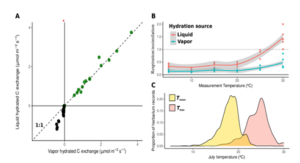 Metabolic activities in symbionts are often described as physiologically synchronized, but sometimes, as in the case of coral bleaching, this synchrony can break down. This breakdown was observed in lichen by Meyer et al. when they examined the physiologies of Evernia mesomorpha fungal and algal components during rehydration using either liquid water or water vapor. Lichen re-activation from desiccation and physiological activities of each symbiont were discovered to be affected by water hydration source. Hydration from water vapor re-activates algal components, and liquid water hydration favors the fungal components. This in turn causes an asymmetry in carbon balance between the lichen association, as carbon assimilation is entirely due to algal activity, whereas respiration is primarily due to the fungal partner. Gas exchange studies revealed the ability of algae associated with E. mesomorpha to achieve maximum carbon assimilation from water vapor hydration alone and transcriptomics analysis confirmed that physiologies of the primary lichen symbionts were decoupled from one another in response to hydration sources. Furthermore, the effect is exacerbated at higher temperatures, indicating that summer rains can contribute to lichen mortality. This asymmetry in carbon balance was also discovered to be common across other evolutionarily disparate lichen associations, highlighting the ecological importance of hydration source when predicting the impacts of climate change on lichens. (Summary by Idowu Arinola Obisesan, @IdowuAobisesan) Sci. Adv. 10.1126/sciadv.ado2783
Metabolic activities in symbionts are often described as physiologically synchronized, but sometimes, as in the case of coral bleaching, this synchrony can break down. This breakdown was observed in lichen by Meyer et al. when they examined the physiologies of Evernia mesomorpha fungal and algal components during rehydration using either liquid water or water vapor. Lichen re-activation from desiccation and physiological activities of each symbiont were discovered to be affected by water hydration source. Hydration from water vapor re-activates algal components, and liquid water hydration favors the fungal components. This in turn causes an asymmetry in carbon balance between the lichen association, as carbon assimilation is entirely due to algal activity, whereas respiration is primarily due to the fungal partner. Gas exchange studies revealed the ability of algae associated with E. mesomorpha to achieve maximum carbon assimilation from water vapor hydration alone and transcriptomics analysis confirmed that physiologies of the primary lichen symbionts were decoupled from one another in response to hydration sources. Furthermore, the effect is exacerbated at higher temperatures, indicating that summer rains can contribute to lichen mortality. This asymmetry in carbon balance was also discovered to be common across other evolutionarily disparate lichen associations, highlighting the ecological importance of hydration source when predicting the impacts of climate change on lichens. (Summary by Idowu Arinola Obisesan, @IdowuAobisesan) Sci. Adv. 10.1126/sciadv.ado2783



